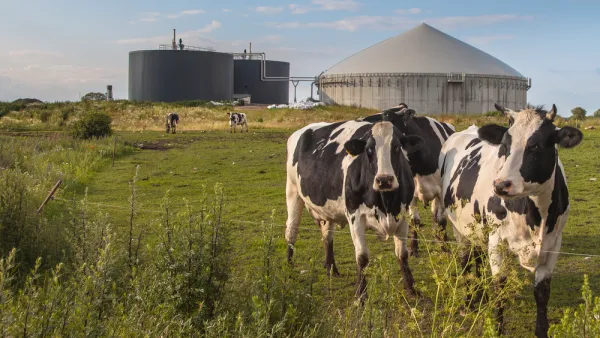Yes, one is with and the other without oxygen, and both divert waste from the landfill—but in terms of the end products, what is the advantage of anaerobic digestion? Simply put, does society face a shortage of compost or renewable energy?
In San Francisco, the green compost bins are ubiquitous. Even the food trucks are required to place bins alongside their trucks for compost, recyclables, and trash. Result: the city is diverting an enormous amount of trash from the landfill to help meet its zero-waste goal and producing lots of compost in the process - a process which also produces a lot of carbon dioxide, "the primary greenhouse gas emitted through human activities," according to the EPA.
A few cities are taking an alternative, more expensive approach to diverting this organic waste called anaerobic digestion and in the process also producing biomethane that is captured for use in electricity generation or used as a transporation fuel. And from a "carbon intensity" perspective, this biogas, also called renewable natural gas, scores at the bottom of carbon intensity chart [PDF, pg. 49] for California's Low Carbon Fuel Standard, i.e. it is one of the cleanest of all transportation fuels.
But this story is not about San Francisco's compost bins nor about the California's Low Carbon Fuel Standard. It is about Brooklyn's Newtown Creek Wastewater Treatment Plant and its anaerobic digestion done by bacteria in "eight huge, shiny, oval-shaped steel tanks known as digester eggs," writes (and states) Joel Rose [listen here].
"Right now, what these bacteria are digesting is mostly sewage sludge. But they're being introduced to a new diet: food scraps. The hope is that this plant will soon take in hundreds of tons of organic waste from houses and apartments.
A bold plan - but one with huge greenhouse gas emission reduction payoffs as food-waste is one of the world's largest sources of emissions as we noted last year.
Anaerobic digestion is more popular in Europe and in a few cities in Canada and California, including San Jose and Los Angeles. While there clearly is a need for more renewable energy, be it in the form of electricity generation or transportation fuels, it is uncertain whether anaerobic digestion will take hold in the U.S. as widespread as composting.
"Right now, it's all in its infancy," says Samantha MacBride, a former New York sanitation official who's now a professor at the City University of New York's Baruch College. "And it's a huge question mark about whether it can grow."
FULL STORY: Turning Food Waste Into Fuel Takes Gumption And Trillions Of Bacteria

Analysis: Cybertruck Fatality Rate Far Exceeds That of Ford Pinto
The Tesla Cybertruck was recalled seven times last year.

National Parks Layoffs Will Cause Communities to Lose Billions
Thousands of essential park workers were laid off this week, just before the busy spring break season.

Retro-silient?: America’s First “Eco-burb,” The Woodlands Turns 50
A master-planned community north of Houston offers lessons on green infrastructure and resilient design, but falls short of its founder’s lofty affordability and walkability goals.

Test News Post 1
This is a summary

Analysis: Cybertruck Fatality Rate Far Exceeds That of Ford Pinto
The Tesla Cybertruck was recalled seven times last year.

Test News Headline 46
Test for the image on the front page.
Urban Design for Planners 1: Software Tools
This six-course series explores essential urban design concepts using open source software and equips planners with the tools they need to participate fully in the urban design process.
Planning for Universal Design
Learn the tools for implementing Universal Design in planning regulations.
EMC Planning Group, Inc.
Planetizen
Planetizen
Mpact (formerly Rail~Volution)
Great Falls Development Authority, Inc.
HUDs Office of Policy Development and Research
NYU Wagner Graduate School of Public Service


























